- Study on optimization of mix ratio of modified cement-based grouting materials based on response surface method
Shuai Liua and Gang Lia,b,*
aSchool of Civil Engineering and Architecture, Three Gorges University, Yichang 443002, China
bSchool of Civil Engineering and Architecture, Jishou University, Zhangjiajie 427000, ChinaThis article is an open access article distributed under the terms of the Creative Commons Attribution Non-Commercial License (http://creativecommons.org/licenses/by-nc/4.0) which permits unrestricted non-commercial use, distribution, and reproduction in any medium, provided the original work is properly cited.
In view of the water inrush disaster in karst area, the slurry has the problems of poor dispersion resistance and low retention rate in the process of grouting and plugging. In this paper, Portland cement is used as the matrix material, and water glass is added to obtain cement-water glass slurry. Then polyacrylamide, iron powder, xanthan gum and guar gum are used as admixtures to develop a new type of grouting material suitable for dynamic water plugging of water channels. The response surface regression model was constructed by Design-Expert software, and the effects of polyacrylamide, iron powder, xanthan gum and guar gum on the setting time, slurry retention rate and compressive strength of the new cement-water glass slurry were analyzed. Combined with the desirability function, the optimal ratio of the new cement-water glass slurry was obtained. The results show that the interaction of each two admixtures has a significant effect on the setting time of the slurry; the single factor of xanthan gum and iron powder had a significant effect on the slurry retention rate. The single factor has a significant effect on the compressive strength of the slurry, and the amount of polyacrylamide has the greatest influence. The model predicts the optimal ratio: polyacrylamide content is 0.6%, xanthan gum content is 0.7%, guar gum content is 0.4%, iron powder content is 29.96%, which can provide a reference for the multi-objective optimization of the mix ratio of the new cement-water glass slurry.
Keywords: Water inrush, Response surface method, Craving function, Mixing ratio optimization.
Grouting is the most commonly used method in the treatment of water inrush disaster in underground engineering, and grouting material is the key factor to control the grouting effect. In the process of grouting and plugging of karst pipelines under high-pressure and large-flow dynamic water conditions, the complex hydraulic environment is faced after the slurry is injected. The traditional Portland cement material is easy to be washed and diluted and dispersed, the retention rate of dynamic water is low, and the volume shrinkage rate is large. In the pipeline dynamic water plugging, ' slurry running ' is serious, which can not meet the needs of large-flow water inrush plugging. Although chemical or polymer grouting materials have stable slurry morphology and high viscosity, the production process is complex, the cost is high, and there is a potential risk of pollution to groundwater, so the engineering applicability is poor [1-4]. Therefore, under the condition of dynamic water, the pipeline grouting plugging puts forward higher requirements on the slurry performance. The anti-erosion performance and gel performance of the slurry are very important to the success of pipeline grouting plugging.
At present, there are many research results in the field of dynamic water grouting materials. Zhang et al.proposed a grouting material suitable for karst development areas, and verified the feasibility of grouting through four indicators : fluidity, spreading ability, initial setting temperature change, and compressive strength [5]. Liu et al.developed a magnesium phosphate cement grouting material with fly ash and abrasive blast furnace slag to meet the requirements of controllable setting time, good fluidity, high early strength and environmental protection [6]. Wang et al. [7].developed a new type of VCH hydrodynamic material, which can resist the erosion of water flow at a certain flow rate. Under the condition of water flow rate lower than 0.4 m/s, the material has good anti-dispersion, and under the condition of flow rate higher than 0.4 m/s, the material loss is greatly improved [8-10]. Geopolymer grouting material (GPGM) outperforms cementitious grouting materials in multiple aspects. It exhibits superior compressive strength, enhanced durability, and excellent corrosion resistance. Moreover, it offers rapid early - strength development and quick hardening properties. Additionally, GPGM is more environmentally friendly and cost - effective, as evidenced by references [11, 12]. Zhang et al. [13] developed A new type of double-liquid grouting material, superfine sulfoaluminate cement based grouting material, in which slurry A is composed of superfine sulfoaluminate clinker, and slurry B is made of superfine anhydrite and superfine quicklime in proportion. The performance and hydration process of lime in the addition process of 0 wt.%-30 wt.% were studied. The flow time, setting time, compressive strength and expansion/contraction tests of swamp cone were carried out by microcalorimeter, DTA-TG, SEM-DES and other technologies. Zhang et al. [14] developed a new type of grouting material for filling karst caverns (in response to groundwater flows) before shield tunnel construction. The material is based on bentonite and cement, adding curing agent, and has excellent fluidity, stability and erosion resistance. Through a series of laboratory experiments, the optimal ratio was determined as follows: specific gravity of bentonite slurry 1.30-1.35, cement content 30%, m-aluminate content 1.25%, lignin content 0.20%.
In recent years, there have been many studies on grouting plugging materials, and some achievements have been made, but there are still many problems. Traditional inorganic plugging materials generally have poor plugging effect, while organic plugging materials have the advantages of anti-dispersion, controllable setting time and superior water retention performance, but there are also environmental risks. In this regard, the research team proposed a new type of cement-water glass slurry. This technology is based on the magnetization principle of magnetic materials, that is, magnetic materials are added to the quick-setting materials, that is, the microstructure of the magnetic materials will change under the action of external magnetic field force. Become more orderly, and then magnetized, the magnetized magnetic material will also produce a magnetic field, which is transmitted to the magnetized magnetic material through the magnetic field magnetic force. The magnet can firmly adsorb the magnetic grouting material, so that the grouting material can resist the erosion of high flow rate of dynamic water. Therefore, this new type of cement-water glass slurry is of great significance for plugging water inrush from karst pipelines.
In order to study the influence of each basic material on the plugging effect of the new cement-water glass slurry, firstly, the influence of different water glass concentrations on the setting time of cement slurry and the compressive strength of stone body was determined by water dilution method, so as to determine the optimal water glass content. In addition, polyacrylamide, iron powder, xanthan gum and guar gum have a great influence on the performance of the new cement-water glass slurry, but there are few studies on the optimization design of the mixture ratio of magnetic quick-setting grouting materials. Generally, the optimal ratio is determined by orthogonal test, but the cross-effect between multiple factors will make the orthogonal test work a lot, and the specific influence of the factors can not be determined within a certain range [15-16]. The response surface method is a method that can establish a mathematical model between multiple factors and one or more response values with only a small amount of experimental data. It can be used to evaluate the influence of multi-factor interaction on the response value, so as to determine the optimal response value [17-18]. Therefore, the response surface method with the advantages of less test times, low cost and high precision has been applied to the optimization of the mix ratio of grouting materials in the field of tunnel engineering [19].
Experimental material
For the selection of modified reagents, since polyacrylamide can well protect the orthosilicate in the water glass solution and enhance the promotion of the hydration process of the water glass cement paste, it can improve the dynamic water anti-dispersion of the slurry [20]. Xanthan gum and guar gum have high viscosity characteristics and active groups, which can improve the anti-dispersion performance of slurry by complexation with cations in cement [21]. Therefore, polyacrylamide, xanthan gum and guar gum were selected as modification reagents.
The new cement-water glass slurry is composed of A and B two liquids. Liquid A is a cement composite slurry composed of cement mixed with iron powder, and liquid B is a solution composed of water glass, polyacrylamide, xanthan gum and guar gum. In this study, ordinary Portland cement (OPC.42.5) produced by Hubei Huaxin Cement Co., Ltd.was selected as the main grouting material, and the chemical composition is shown in Table 1.
The accelerator used in the test is liquid water glass, purchased from Beijing Pharmaceutical Chemical Reagents Co., Ltd., with a modulus of 3.3, a baume degree of 40, a sodium oxide content of 8.3%, a silicon oxide content of 26.2%, and a density of 1.35 g/cm3.
The magnetic powder used in the test is produced by Hebei Casting and Research Alloy Materials Co., Ltd., which is micron spherical ferric oxide (iron) powder with a content of 99 (%) ferric oxide.
The water-soluble plant gums used in the experiment were food additives xanthan gum and guar gum, which were purchased from Shandong Fufeng Fermentation Co., Ltd., and their chemical structures are shown in Fig. 1 [21].
Experimental procedure
According to the experimental ratio formulated by the experimental scheme, the raw materials were weighed and poured into the stirring pot to quickly stir to form a uniform grouting material. (1) A part is used to test the fluidity and gelation time of grouting material; (2) The other part is poured into a square rubber mold with a side length of 20 mm. After the grouting material is hardened and molded,the samples were placed in a curing box with a temperature of (20 ± 1) °C and a humidity of ≥ 90%, and the curing time was set to 28 days for compressive strength test. (3) The last part of the grouting material is poured into the magnet in the flowing water pipeline to test the dynamic water retention rate of the grouting material. The preparation flow chart of modified magnetic cement-water glass grouting material is shown in Fig. 2.
Experimental programme
RSM is a statistical method used to study multi-index problems in mathematical statistics. The three-level four-factor experimental design was used to optimize the mixing ratio according to the response values X and Y. The design included three levels (high, medium and low), and a total of 29 runs were repeated to optimize the level of the selected variables. Based on the previous single factor experiment of our team, a reasonable data range was provided for the influencing factors of orthogonal experiment. Four influencing factors were determined by orthogonal experiment, including : polyacrylic acid amine content (X1), iron powder content (X2), xanthan gum content (X3), guar gum content (X4). For statistical calculation. The experimental design and test results of the composite material are shown in Table 2, and the corresponding experiments are carried out. The determination coefficient (R2), analysis of variance (ANOVA), contour and response surface were used to analyze the test results.

|
Fig. 1 Graph of chemical structures. |
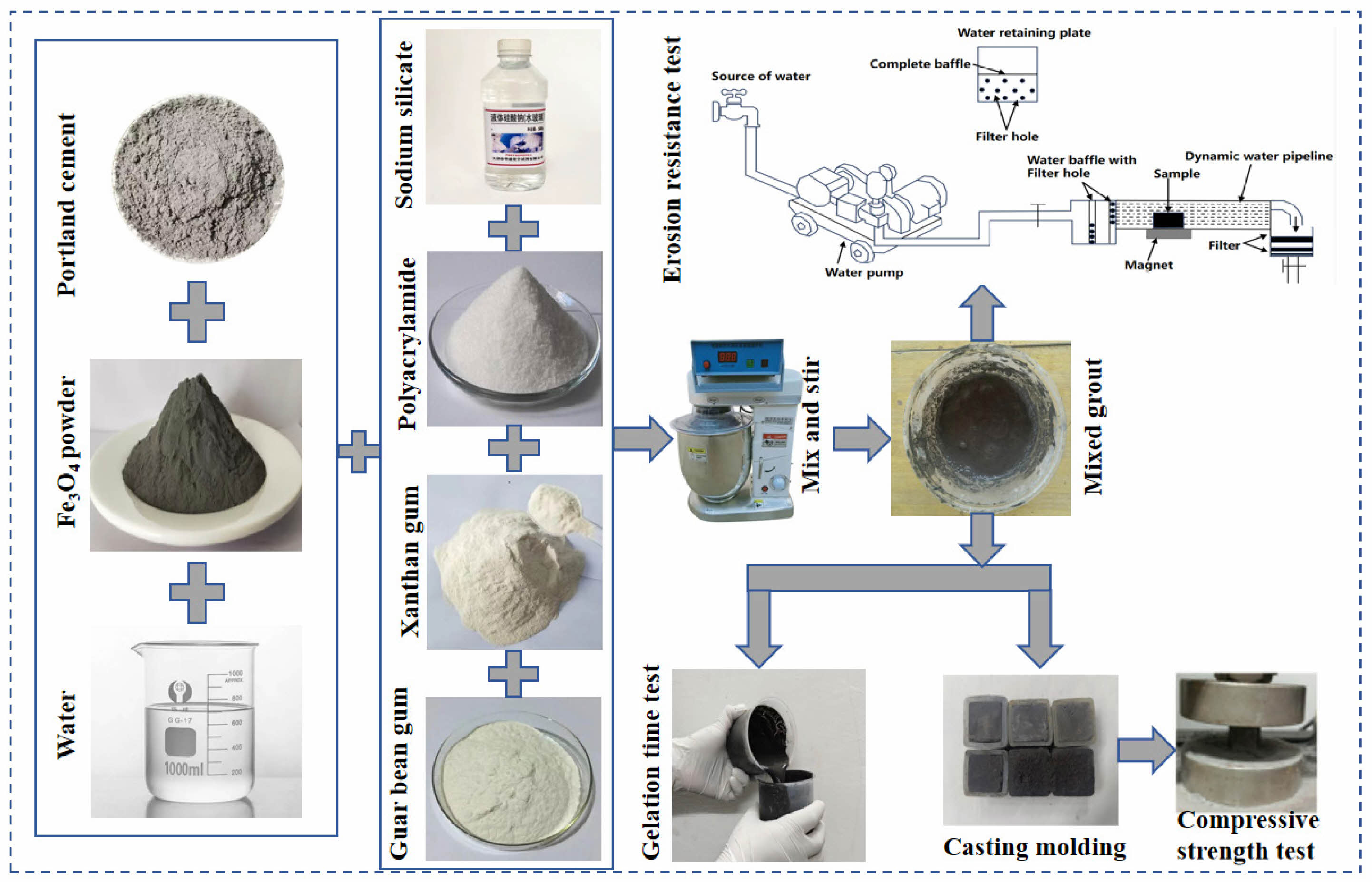
|
Fig. 2 Flow chart of preparation and performance test of modified magnetic cement-water glass grouting material. |
Response surface regression equation
The Design-expert software was used to perform multiple regression fitting analysis on the measured values of the test. The quadratic polynomial response surface regression equations of setting time (Y1), slurry retention rate (Y2), compressive strength (Y3) and independent variable factors X1, X2, X3, and X4 were established:
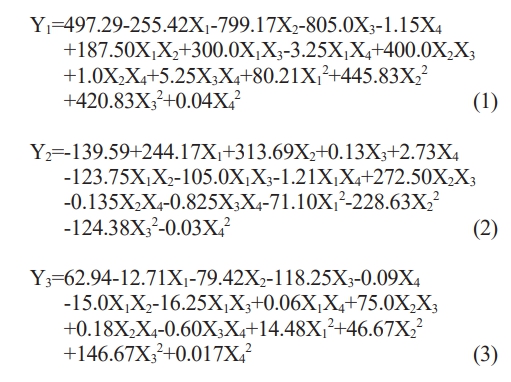
Regression model analysis of variance
The variance and reliability analysis of the established regression model were carried out to evaluate the accuracy of the response surface regression model. The results are shown in Tables 3~6. The P value represents the probability that the initial hypothesis is true, P ≤ 0.05, indicating that the model is significant and the response value prediction reliability is high ; on the contrary, it means that the model is less significant and the regression model is not available.
Correlation coefficient R2, adjustment coefficient Ra2, prediction coefficient Rp2, coefficient of variation and signal-to-noise ratio were used to comprehensively evaluate the credibility of the model. R2 represents the difference between the response value and the true value, and the value is 0~1. The larger the value, the smaller the difference between the two values. If the signal-to-noise ratio is greater than 4, the smaller the difference and coefficient of variation between Ra2 and Rp2, the higher the fitting degree of the regression equation, the higher the reliability and accuracy of the test.
The analysis of Table 3-5 shows that the regression models of Y1, Y2 and Y3 have high significance and reliability, and the regression models of Y1, Y2 and Y3 have high significance and reliability. The P value of AB, AC, BC, AD and CD in Y1 is 0.05, which shows that the interaction between the four factors of polyacrylamide content, xanthan gum content, guar gum content and iron powder content has a significant effect on the setting time of the slurry. In addition to the interaction between xanthan gum and iron powder content, the effect of the interaction is small, and the effect of single factor iron powder content on the setting time of the slurry is also small. In the modified slurry system, iron powder plays a role similar to aggregate, mainly plays a role of filling and supporting, rather than dominates the chemical reaction process, so it has little effect on the setting time of slurry. The viscosity of the modified slurry increases under the action of magnetic field because the magnetic field causes the iron particles in the slurry to be attracted by the magnetic force to form a chain or cluster structure, which increases the internal friction. At the same time, the magnetic moment of the particles is consistent with the magnetic field constraint orientation, which enhances the interaction between the particles and hinders the fluid flow together. Table 4 Table 6
The P value of AB, AC, AD and BC in Y2 was 0.05, which indicated that the single factor of xanthan gum and iron powder had a significant effect on the slurry retention rate. The interaction between xanthan gum, guar gum and iron powder had little effect on the slurry retention rate.
Regression model residual analysis
By using the ANOVA function of the Design − expert software, the studentized residuals of the regression model can be derived. Studentized residuals play a very important role in the diagnosis of regression models [21]. It refers to the value obtained by dividing the residual by the standard deviation, which can intuitively judge whether the residual term obeys the normal distribution. The studentized residuals of the regression model of setting time, slurry retention rate and compressive strength are shown in Fig. 3. The analysis shows that there are no abnormal data points in the regression model, and the data points are evenly distributed near the straight line, indicating that the residual is small and the fitting effect of the model is ideal.
Contour and response surface analysis
This article is limited to space, only the response value Y2 slurry retention rate is analyzed, and the corresponding surface diagram and contour map of each response value are shown in Fig. 4. When the contour shape of the response surface is elliptical, it indicates that the interaction between the two factors is significant; the circle indicates that the interaction is not significant. The denser the intersection of the contour line and the coordinate axis, the greater the influence of this factor on the response value.
The analysis Fig. 4(a) shows that the response surface curvature is large. When the content of guar gum is 0.4% and the content of iron powder is 30%, the content of polyacrylamide is not more than 0.8%, and the slurry retention rate increases with the increase of xanthan gum content. When the content of polyacrylamide is more than 0.8%, the slurry retention rate decreases with the increase of xanthan gum content. The density of the vertical axis contour line is greater than that of the horizontal axis, indicating that the amount of polyacrylamide has a greater impact on the slurry retention rate. When the polyacrylamide content is in the range of 0.7%-0.8% and the xanthan gum content is in the range of 0.6% -0.7%, the slurry retention rate reaches a maximum value of 92.56%. It can be seen from Fig. 4(b) that the interaction between polyacrylamide content and guar gum content is significant. The larger the amount of guar gum is, the smaller the amount of polyacrylamide is, and the greater the slurry retention rate is. The smaller the amount of guar gum, the greater the amount of polyacrylamide, the greater the slurry retention rate. When the content of xanthan gum is 0.7%, the content of iron powder is 30%, and the content of guar gum is more than 0.3%, the slurry retention rate decreases with the increase of polyacrylamide content. When the content of guar gum is less than 0.3%, the slurry retention rate increases with the increase of polyacrylamide content. Polyacrylamide is a kind of linear polymer, which can interact with other materials to form flocs and settle rapidly in water. It has the function of anti-dispersion under water and achieves the purpose of blocking large flow and high head. Therefore, under the condition of low content of guar gum, polyacrylamide has better dissolution effect in water, which can settle quickly without dispersion, and can block water inrush. However, when the amount of guar gum is large, too much polyacrylamide will lead to a decrease in the internal structure of the slurry. The maximum value of slurry retention rate appears in the range of 0.7%-0.9% polyacrylamide and 0.25%-0.35% guar gum.
It can be seen from Fig. 4(c) that the interaction between polyacrylamide and iron powder is not significant. When the content of xanthan gum is 0.7% and the content of guar gum is 0.4%, the slurry retention rate has a maximum point in a certain range. This is because polyacrylamide itself has the function of adsorption and precipitation, which makes the slurry settle rapidly in water, and is not easy to be washed away under high flow rate. However, after adding iron powder, it is easy to disperse by magnetic field attraction, and the interaction with polyacrylamide is affected.
It can be seen from Fig. 4(d) that when the iron magnetic powder is 30 % and the xanthan gum content is ≥ 0.6%, the slurry retention rate decreases with the increase of polyacrylamide content. When the xanthan gum content is < 0.6%, the slurry retention rate increases with the increase of polyacrylamide content. Therefore, the interaction between xanthan gum and guar gum was significant. The maximum value of slurry retention rate occurs when the amount of xanthan gum is 0.5% -0.7% and the amount of guar gum is 0.25% -0.35%. Xanthan gum has the characteristics of low concentration and high viscosity, which plays a thickening role; guar gum has good water solubility, interacts with it, and has high viscosity characteristics. When the amount of xanthan gum is large, the water-soluble vegetable gum composed of guar gum can complex with the cations in the cement, thereby improving its dynamic water anti-dispersion performance, that is, the slurry retention rate is improved ; when the amount of xanthan gum is small, the complexation will also be affected, resulting in a significant reduction in the retention rate of the slurry.
It can be seen from Fig. 4(e) that when the amount of guar gum is 0.4% and the amount of xanthan gum is in the range of 0.5%-0.7%, the change trend of slurry retention rate with the amount of iron is the same. It can be seen that the interaction between xanthan gum and iron powder is not significant. When the dosage of xanthan gum is 0.6% and the dosage of iron is 20%, the slurry retention rate reaches the maximum point.
It can be seen from Fig. 4(f) that when the amount of xanthan gum is 0.7% and the amount of guar gum is in the range of 0.25%-0.35%, the change trend of slurry retention rate with iron content is the same. It can be seen that the interaction between guar gum and iron powder is not significant. The slurry retention rate reaches the maximum point when the amount of guar gum is 0.3% and the amount of iron is 20%.
Multi-objective hybrid optimization and verification
Combined with the response surface regression model and the numerical optimization function in Design-Expert software, the multi-objective optimization of the new cement-water glass slurry ratio was carried out, and the maximum response values at different factor levels were found. The optimization design target and optimization parameter range of the new cement-water glass slurry ratio in Table 7 are input into the Design-Expert software to obtain the optimal mix ratio and maximum setting time, slurry retention rate and compressive strength, which is the optimal design result of the response surface design, as shown in Table 8. Compared with the quick-setting material CIS [21] slurry and ordinary cement-water glass slurry commonly used in engineering, the optimized new cement-water glass modified slurry has shorter setting time, higher strength and slurry retention rate [22, 23].
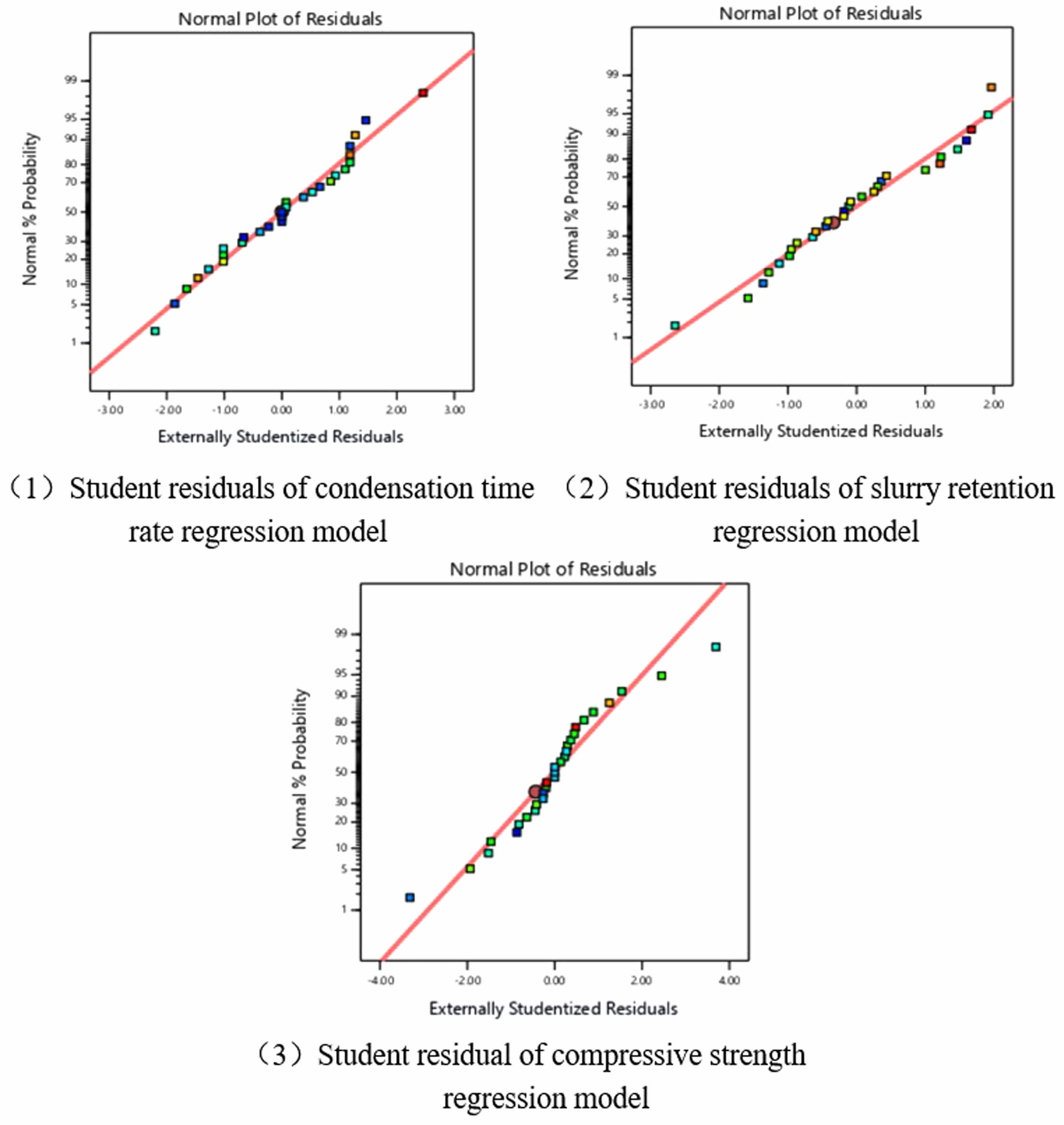
|
Fig. 3 Regression model residuals. |
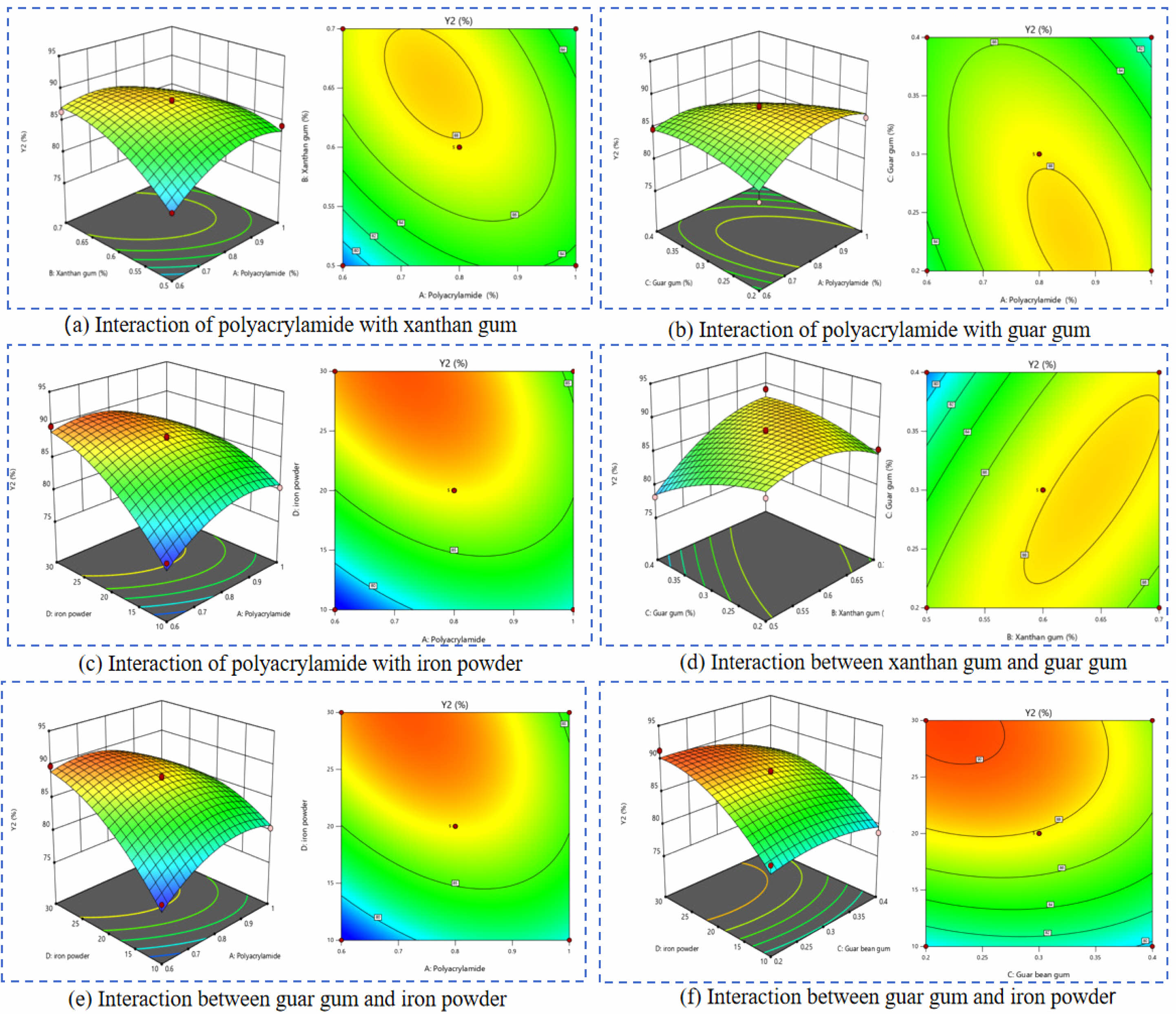
|
Fig. 4 Retention response surface diagram and contour diagram. |
(1) In ordinary cement-water glass slurry, polyacrylamide, ironpowder, xanthan gum and guar gum were added to construct the response surface regression model of slurry setting time, retention rate and compressive strength. The variance analysis and test showed that the model was effective and reliable with high reliability.
(2) For the setting time, slurry retention rate and compressive strength of the new cement-water glass slurry, the interaction between the four factors has a significant effect on the setting time of the slurry. The single factor of xanthan gum and iron powder had a significant effect on the slurry retention rate. The interaction of xanthan gum, guar gum and iron powder had little effect on the slurry retention rate. The influence of single factor on the compressive strength of the slurry is much more significant than the interaction of the two factors on the compressive strength of the slurry.
(3) The optimal mixture ratio predicted by the response surface model is 0.6% polyacrylamide, 0.7% xanthan gum, 0.4% guar gum and 29.96% iron powder.
Gang Li: Conceptualization, Investigation, Shuai Liu: Writing—original draft. Authors have read and agreed to the published version of the manuscript.
The authors declare no conflict of interest.
The datasets used and/or analyzed during the current study are available from the corresponding author on reasonable request.
Not Applicable (N/A).
- 1. Y. Jingqiang, C. Weizhong, and T. Xianjun, Chin. J. Rock Mech. Eng. 34[5] (2015) 960-967.
- 2. D. Mingxin, L. Xunkui, and Z. Xiangdong, China Coal Geology. 33[10] (2021) 100-102.
- 3. L. Rentai, L. Shucai, and Z. Qingsong, Chin. J. Rock Mech. Eng. 30[7] (2011)1454-1459.
- 4. L. Yongbin, China Coal Geology, 34[1] (2022)52-56.
- 5. Y. Zhang, S. Wang, B. Zhang, D. Hou, H. Li, L. Li, J. Wang, and C. Lin, Constr. Build. Mater. 237 (2020) 117501-117501.
-

- 6. Y. Liu and B. Chen. Constr. Build. Mater. 214 (2019) 516-526.
-

- 7. J. Wu, S.C. Li, Z.H. Xu, and J. Zhao, Tunn. Undergr. Space Technol. 85 (2019) 43-55.
-

- 8. J.H. Hwang and C.C. Lu, Tunn. Undergr. Space Technol. 22 [1] (2007) 39-46.
-

- 9. S.C. Li and J. Wu, Bull. Eng. Geol. Environ. 78 (2019) 1761-1776.
-

- 10. D. Zhao, A.P. McCoy, B.M. Kleiner, and T.L.S. Jackson, Safety Science 77 (2015) 143-151.
-

- 11. N. Ranjbar, M. Mehrali, U. Alengaram, H.S.C. Metselaar, and M.Z. Jumaat. Constr. Build. Mater. 65 (2014) 114-121.
-

- 12. L. Zhang, X.X. Han, J. Ge, and C.H. Wang, IOP Conf. Ser. Mater. Sci. Eng. 292 (2018) 012114.
-

- 13. J. Zhang, X. Guan, H. Li, and X. Liu. Constr. Build. Mater. 132 (2017) 262-270.
-

- 14. C. Zhang, F. Jinyang, J. Yang, O. Xuefeng, X. Ye, and Y. Zhang, Constr. Build. Mater. 187 (2018) 327-338.
-

- 15. Z.L. Li, X.H. Wang, and L. Z. Xie, Electron. J. Geotech. Eng. 17U (2012) 2933-2942.
- 16. T. Wei, D. Zhang, and L. Chen, Constr. Build. Mater. 47 (2015) 89-92.
- 17. S.A. Khan, S.M.U. Ghazi, H. Amjad, M. Imran, and R.A. Khushnood, Constr. Build. Mater. 411 (2024) 134815.
-

- 18. M.N.-T. Lam, D.-H. Le, and D.-L. Nguyen, Constr. Build. Mater. 373 (2023) 130801.
-

- 19. X. Wang, K. Chen, and Y. Zhang, Build. Eng. 2[2] (2024) 1451.
-

- 20. W. Wei, Q. He, S. Pang, S. Ji, Y. Cheng, N. Sun, and Y. Liang, Front. Mater. 11 (2024) 1501604.
-

- 21. S.A. Lowe, Build. Eng. 2[2] (2024) 1381.
-

- 22. Y. Zhao, X. Yue, Y. Tang, X. An, and X. Shang, J. Ceram. Process. Res. 25[5] (2024) 862-870.
-

- 23. S. Du, Z. Fu, and H. Gu, J. Ceram. Process. Res. 24[6] (2023) 921-925.
-

 This Article
This Article
-
2025; 26(2): 352-361
Published on Apr 30, 2025
- 10.36410/jcpr.2025.26.2.352
- Received on Jan 26, 2025
- Revised on Mar 7, 2025
- Accepted on Mar 11, 2025
 Services
Services
- Abstract
introduction
experimental materials, procedures and programs
results and discussions
conclusion
- Author Contributions
- Conflict of Interest
- Data availability statement
- Funding
- References
- Full Text PDF
Shared
 Correspondence to
Correspondence to
- Gang Li
-
aSchool of Civil Engineering and Architecture, Three Gorges University, Yichang 443002, China
bSchool of Civil Engineering and Architecture, Jishou University, Zhangjiajie 427000, China
Tel : +86 15090139682 Fax: +86 15090139682 - E-mail: ligangzjj@163.com







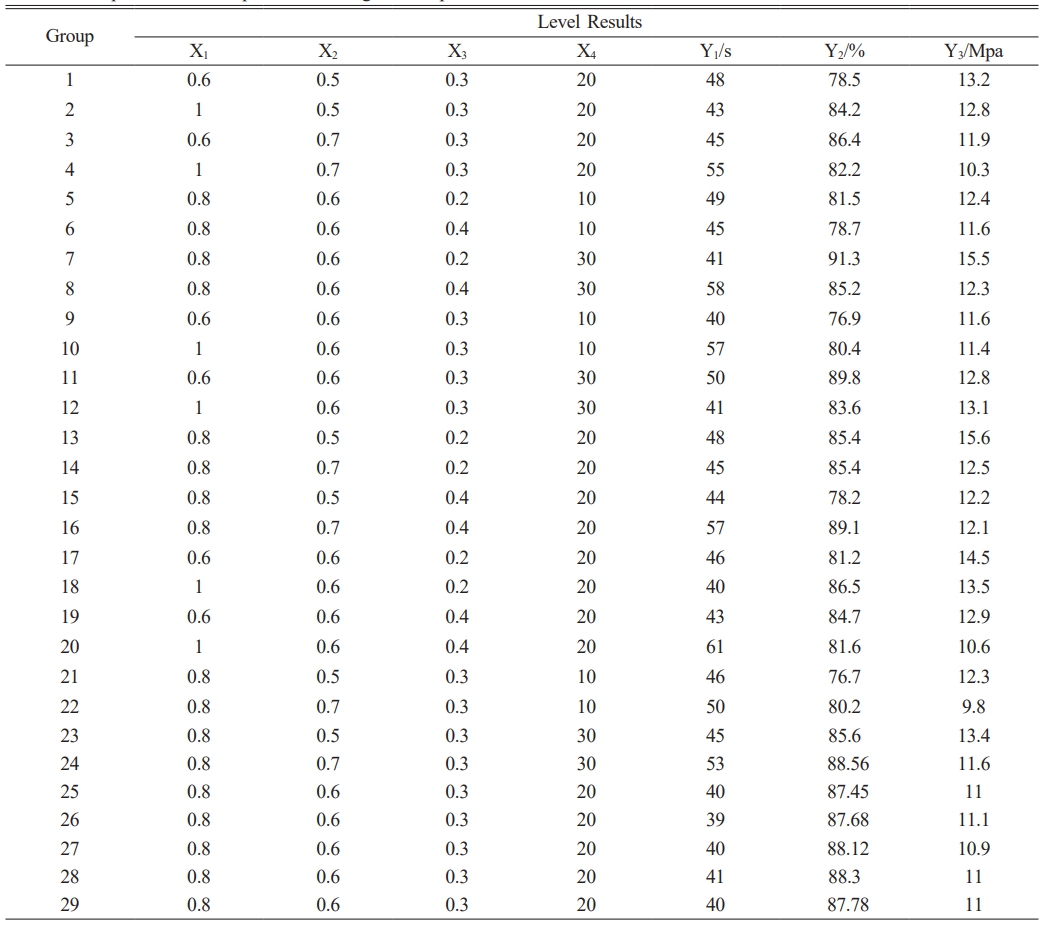
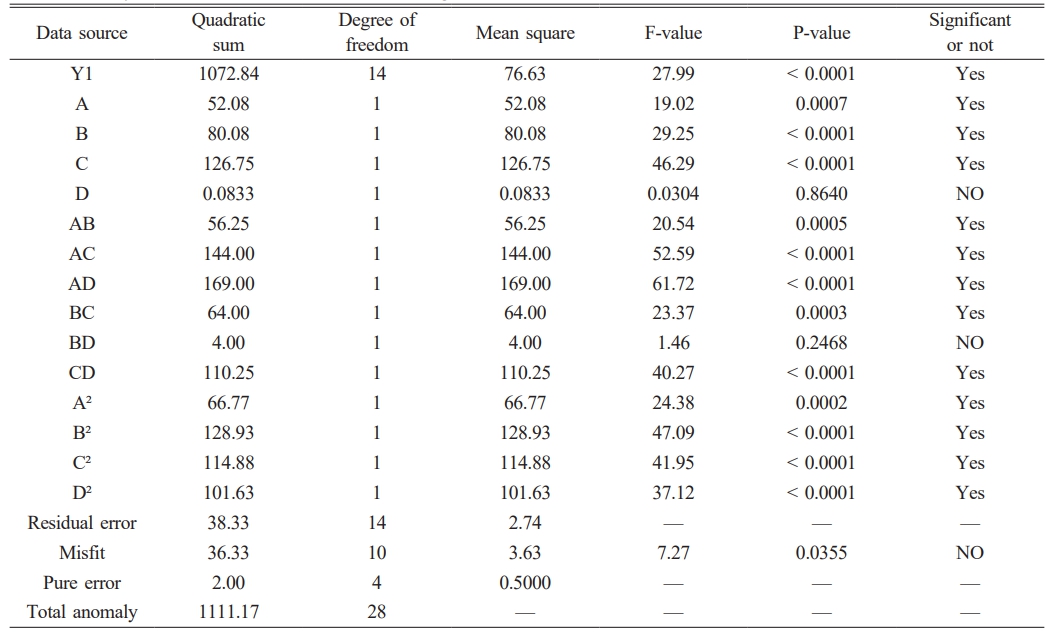
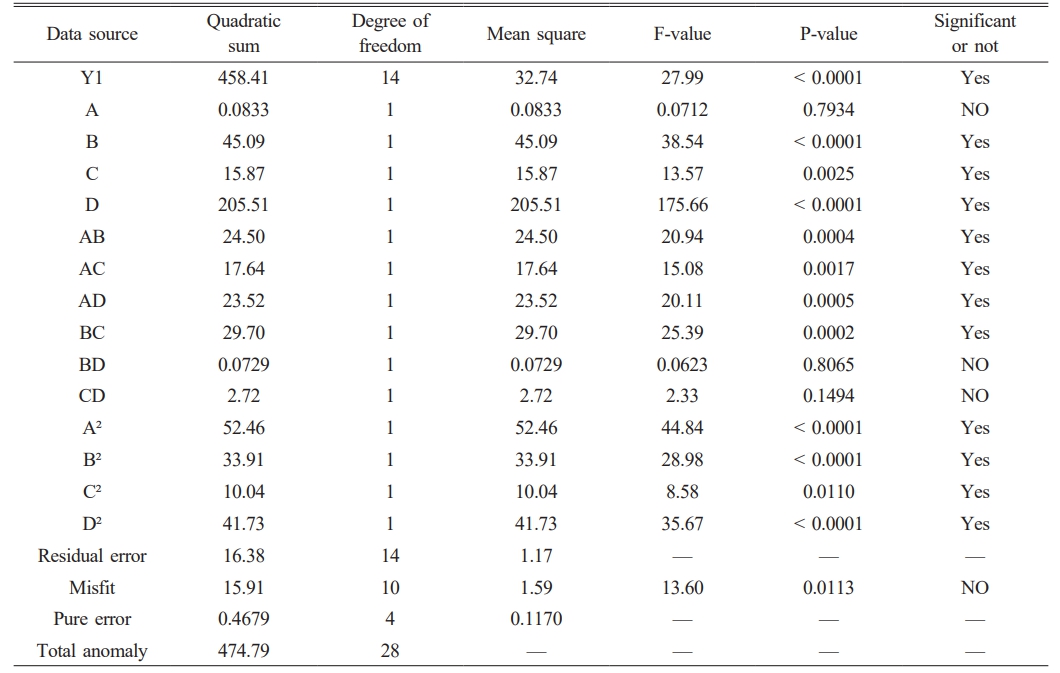
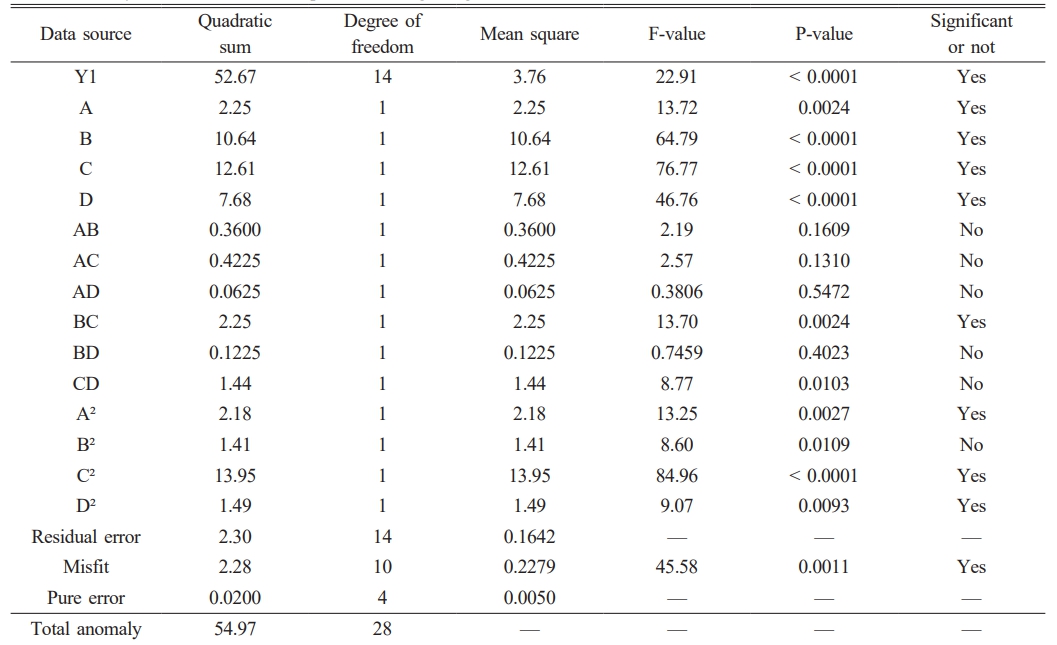

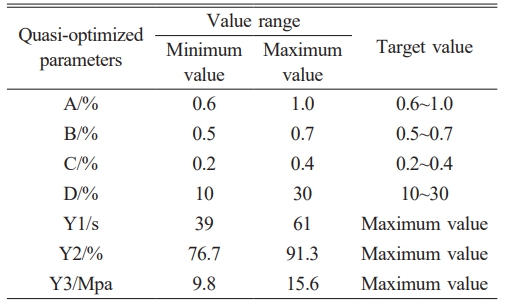

 Copyright 2019 International Orgranization for Ceramic Processing. All rights reserved.
Copyright 2019 International Orgranization for Ceramic Processing. All rights reserved.